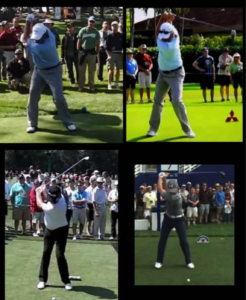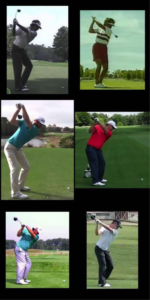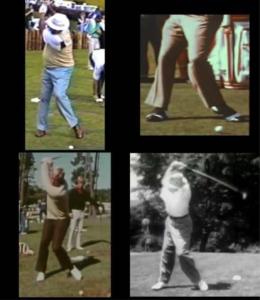
This is a guest post by Adam Young, author of the best-selling book The Practice Manual
Prepare yourself - this article is going to make you think!
I do over a thousand hours of coaching each year - each time, I ask my pupils the question
What do you think you need to do to create a good shot?
I am then invariably met with responses of cliches which players believe to be true, usually based on things they have heard, or things which have been perpetuated throughout the golf industry. In this article, I am going to go through those cliches and show you that they are not the cause of your bad shots. Then I will offer some advice at the end on what you should actually be working on.
Let's go..
Head Up
If I had a dollar for every time I heard the phrase “I looked up” after a topped shot, I would be a rich man. But is looking up really the cause of your bad shot?
I have often recorded a player after both topping the ball and striking one pure. I have not yet seen a player look up earlier during the topped shot. They often Believe they have, but it’s just not true. Even if your 15 handicap buddies tell you that you did.
And, if looking up early did cause a topped shot, both Annika Sorenstam and David Duval wouldn’t have reached number one in the world (and shot a 59) doing so – like the below pictures show.

Not only that, but forcing yourself to ‘Stay down’ is actively sabotaging your ability to strike the ball with any consistency. I am not going to go into the complexities of why in this article, but trust me – throw this myth away NOW.
I keep over-swinging
Ah, one of my favorites. Why? Because I spent many years trying to ‘fix’ my own overswing, and I wish I hadn’t. Such wasted time that I could have better spent on more relevant things to develop.
So, you think that an overswing is causing you to hit the ball poorly? Well, how are these guys below so successful?

What is an ‘over swing’ anyway? Surely you can only swing over something if there is a pre-defined ideal? Is swinging parallel to the ground ideal? Well, what about these guys then?

There are some pretty good players in both categories. I wouldn’t mind having their bank accounts.
Your feet have to stay still
What, like this guy's feet?
Or Lexi Thompson?
These players are dancing their way to the bank.
In fact, Bubba is one of the best drivers of the ball in the world, for combined accuracy and distance.
Have a look at these players with 'stable footwork'

My left arm is bending at the top
Yeah, because that is the cause of your 40 yard banana ball, right? Wrong – or these guys wouldn’t be able to hit it great.

But my left arm bends at impact
This one is controversial, and if you knew what I knew about how the golf swing works, you would throw this myth out too. I’m not going to say anything more than that, other than to show you some pictures of some of the best strikers in the world with splayed elbows and bent lead arms at impact.

Just because a pro may have straighter arms at impact does not mean they are actively trying to straighten them. In fact, it could be the complete reverse. Think about this – in a game of tug of war, just because the other team is pulling you in one direction doesn’t mean you are not pulling in the opposite direction. Golf is a game of tug of war with a clubhead which effectively weighs many times more as it is being swung through impact.
Oh, by the way – combine trying to keep your left arm straight with the head down myth – good luck with breaking 100.
My clubface is closed at the top
Oh your clubface is closed – like these guys?

Or is it more ‘toe-down’ at the top, like these guys?

I wouldn’t mind any of their playing records.
My front foot comes up in the backswing
You know, before we all got taught to keep our feet on the ground, there were a ton of guys who did that too – and they played great golf. Even Bubba Watson now (who wasn’t taught at all, so wasn’t exposed to this myth) lifts his front foot.

Just because a myth has become perpetuated to the point it is no longer questioned does NOT make it correct.
My takeaway isnot Correct
Define correct.
Now think here – really think hard. WHY is that ‘correct’? Who decided? And what did that decision based upon? Do you think there is a chance it may be less relevant than you thought?
Besides, which one of the below takeaways is ‘correct’. These guys?

Or these ones?

You decide
What are they talented at?
This is a much better question, and it brings us closer to the fundamental difference between you and a professional. Read this line over and over and over……. Until it haunts your dreams
The biggest difference between a professional and an amateur is how the club impacts the ball
That’s right! This below video shows the most important part of an entire golf swing – impact. And I am not talking about body positions at impact – I am talking about how the club and the ball interact through that fraction of space where they are in contact with one another.
So, if this is all that matters to the golf ball, wouldn’t it be a good idea to work on this stuff directly? Wouldn’t it be better to improve our understanding of it, as well as our ability to get the desired impact.
Style versus function
The overriding message in every forum, every magazine and every book (apart from my own) is to improve your style to improve your function. Swing it this/that way – move your body like this/that etc is all dished out in the hopes that it improves impact function.
But do you teach a child the mechanics (style) of putting a fork into their mouth in order to get the function (feed themselves)? Or, does form (mechanics) arise as a result of improved function, with focus on the function itself?
We all know the answer to that, unless you are teaching your kids how to bend their arms and wrists to feed themselves.
Wait, was it alpha or gamma torque I need to apply? I'm so hungry
When technique arises as a result of function, it is far more adaptable. A child who learns simply to put the fork into their mouth can do it with many different techniques – with the arm taking different trajectories into the mouth, or even with their elbow on a table.
A child who learns through a set of defined commands will may produce a functional (albeit unnatural technique), but it will be far less adaptable.
Your brain will co-ordinate all the necessary variables into an appropriate blend, if it has function as its primary objective.
So, style is irrelevant?
I am not saying that style is irrelevant – far from it. But I am saying that the common perception of what is important in the golf swing is far from the truth – as evidence by the vast amount of players with different styles on tour.
And the kicker?
These players have often come to these styles IN SPITE of being taught commonly held beliefs about perfect takeaways etc.
There ARE some commonalities among good players, but you are not going to find those things in your magazines. And, most of the time people are actively sabotaging themselves by following the above myths. There ARE certain swing mechanics which produce bigger margins for error/more technical repeatability, but one thing is true
Any style change you make should serve a purpose. It should
- Improve impact
- Improve repeatability of impact
- Reduce injury
You should NOT be making swing changes simply to look prettier or more like your favourite model.
Skill training and self-organizing
What most people don’t understand is that biological organisms (of which we are one) will automatically develop technique as a result of improved function. This phenomenon is called self-organizing. For example, we self-organize the complex techniques involved in walking simply by improving the function of walking, not by focusing on what bits are moving and when.
There are ways of actively speeding up this process of self-organizing appropriate technique, but most people actively sabotage and slow down the process by incorrect learning methods, or trying to learn the wrong things.
But I’ve heard that pros have worked on X/Y/Z
Sure, Tiger has worked on quieter footwork, and tons of other players have worked on swing plane, takeaways etc.
But, if I took a beginner sprinter and weighed them down with a lead weight and then trained them for 5 years, would they get better at sprinting? Sure they would. But it may be IN SPITE of the lead weight, not because of it.
Alternatively, a player may be a world-beater after I give them a magic tee to put in their back pocket. But anybody would be a fool to think that the magic tee was the cause of the success. Correlation does not equal causation.
Take home messages
Technique matters – but most things that the average amateur deems ‘correct technique’ can seriously be called into question. Unless a technique helps you achieve a more consistent or better impact (or in a safer way for your body), it is a waste of time. If you are busy trying to get your club ‘on-line’ at the top, is that really improving your function? Or is it just a lead weight or a magic tee?
We should focus more on improving function. In my book “The Practice Manual”, I outline new ways for developing better golf based on an understanding of motor learning research. I look at skill development approaches, as well as ways to better self-organize technique.
The main messages I want everyone to get is that
- There are much wider acceptable boundaries of swing style which will produce function
- Lots of things held dear as technical ‘musts’ are nothing more than old wives tales
- Pro’s have more skill – let’s work on developing skill
- Skill is different to technique
- Form can (and does) arise from function.
- Using motor learning research, we can figure out better ways of learning
- Direct technical changes should be a supplement to a good training program - not dominate it
- There is more to a golfer than their swing style. Trying to get good at golf by only improving your swing style is myopic, at best.
I understand that many of you will have strongly held beliefs challenged after this article. Good. Maybe it will open your eyes to why you are not as good as you should be.
Check out Adam's best-selling book "The Practice Manual". You can also visit his website for more articles.

We care about the protection of your data Read our Privacy Policy